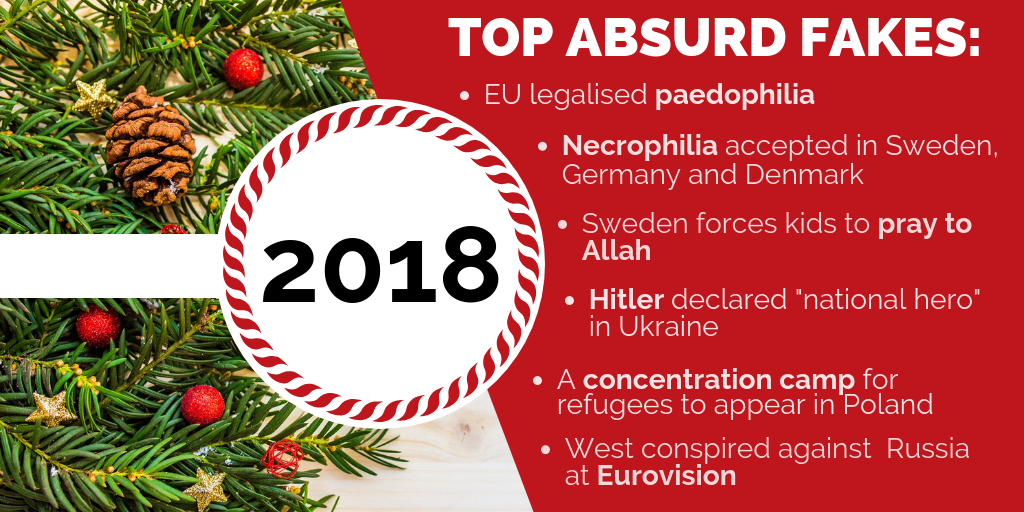The first articles are devoted to the Balkan country of Montenegro, and the Nordic countries of Sweden and Finland. The goals and narratives of the Russian propaganda campaigns differ depending on each state. However, the common feature is the possible use of a wide range of tools attempting to achieve a certain foreign-policy goal. And propaganda is just one of the tools used.
Sweden
Unlike other parts of the world, the Russian state-run channel Sputnik didn’t survive long in the Nordic countries. Its only Nordic outlet, in Sweden, lasted less than a year before it shut down.
However, Sweden didn't fall off the Russian radar after the failure of Sputnik and Russian mass media continued spreading disinformation about the Nordic country.
One of the main Kremlin's narratives about Sweden is the issue of migration. Following the logic of exploiting already existing divisions in society, this is used in order to describe Sweden as unstable and to create fear
.
EU vs Disinfo reminds of a few cases of faking the stories by the Russian media, among which is attempt to hire locals to film a fake footage to prove the narrative being pushed:
"When Russian state-controlled TV station NTV went to Rinkeby in 2017, a suburb of Stockholm which had seen social unrest at the time, it seems they wanted to see some action. As reported by both Swedish and Danish media, local teenagers were approached by the Russian TV crew and offered money ‘to do some action in front of the camera’. As the TV crew had missed the ‘real’ action a couple of days earlier, they allegedly wanted some footage to match their reporting."
To protect Sweden from hostile influence operations similar to disinformation campaign which accompanied the Russian annexation of the Ukrainian peninsula of Crimea, Sweden adopted a new security strategy. State special agencies briefed all political parties on the issue and gathered representatives of mass and social media for a dialog on the problem of disinformation.
The Swedish Civil Contingencies Agency (MSB) also published a Handbook for Communicators, meant as a tool for dealing with disinformation. The most important thing in order to create resilience is to build awareness about the threat of hostile foreign influence operations and to improve the capacity for critical thinking among the population, according to MSB.
Read the full article: In Sweden, Resilience is Key to Combatting Disinformation
Read more:
- Denmark and Sweden to cooperate on combating Russian fake news
- Intimidation as a propaganda tool in the Nordic countries
- The pro-Kremlin narrative about migrants in Europe
- Gotland – the Danzig of our time
Finland
Finland, another Nordic country, is usually almost absent from the agenda of the Russian state-controlled TV channels. Therefore, the peaks in the visibility are easy to detect. According to EU vs Disinfo, since 2009, Russian disinformation campaigns against Finland have come in waves, sometimes more frequent, sometimes less.
As EU vs Disinfo highlights, such campaigns could have various goals. They could be about provoking tensions within the 75,000 Russian speaking community in Finland by eroding their traditionally high trust in local officials. Another aim might be to wear down the overwhelmingly positive image of Finland internally in Russia.
The Finnish response to the Russian actions has been a mix of proactive public diplomacy and communication.
For example, to debunk the Russian narrative on juvenile terror in Finland, the state has organized visits for the journalists of the reliable Russian media to Finland, communicating the facts of the Finnish childcare system in Russian and stepping up the capacity to do so immediately when a new campaign starts.
And in 2014 Finland set up a network of government officials to address influence operations and started training officials. In 2016, the European Centre of Excellence for Countering Hybrid Threats (Hybrid CoE), open to EU member states and NATO allies, was established in Finland.
Read the full article: “Finland puts Russian kids in prison” – Disinformation that Shaped the Minds of Millions
Read more:
- Kremlin disinformation campaign extremely successful
- “Russia’s bunker busters will reach Finns underground” – how to ridicule and threaten at once
- Russia experts call for lustration in Finland
Montenegro
In the last couple of years, the Kremlin paid special attention to Montenegro since this Balkan country was about to enter NATO. According to a recent study by the Foreign Policy Research Institute (FPRI), during the period in question, the Kremlin applied several well-known influence tactics to gain influence in the country, disinformation was among them.
As Russian efforts to hinder Montenegro’s NATO accession failed, the Kremlin came up with a new strategy, “stoking political and ethnic divisions to destabilize Montenegro and preclude further Western integration,” the report concludes.
The anti-NATO narratives spread by Russian officials were familiar to those regularly used in Russian disinformation. The Montenegrin NATO accession was described as a "provocation" against Russia, and the threatening remarks were used in their comments.
As of now, Russian agents are being tried in Montenegro for their involvement in an attempted coup d’état in 2016. Both Russia spy agencies, the military intelligence agency (GRU) and Federal Security Service (FSB), are thought to have been behind the planning. The Russian goal was to instigate political violence to trigger nationwide protests and topple the government. Montenegrin authorities, however, successfully prevented the coup attempt.
Read the full article: Russian Influence in Montenegro: Disinformation, Threats, and Attempted Regime Change
Read more:
- Russia will continue efforts to destabilize Montenegro, expert says
- Montenegro bans entrance to 149 Russians and Ukrainians over Russian aggression in Ukraine
- Can there be another coup in Montenegro?
- Plans for a "Great Serbia" and the Kremlin's hybrid war in the Balkans
- The Western Balkans are becoming Russia's new playground
Read also:
- Internet bots are key players in propelling disinformation
- Twitter's new policy misused by pro-Kremlin accounts
- Email chains and other Russia's propaganda tools
- How pranksters are used as a pro-Kremlin propaganda tool
- 25 ways of combatting propaganda without doing counter-propaganda
- How Russian propaganda uses the victim-blaming strategy against Ukraine
- Fake Western experts as a propaganda tool on Russian TV
- Kremlin trolls are engaged in massive anti-Ukrainian propaganda
- Internet bots are key players in propelling disinformation
- 15-point checklist of Putin regime's propaganda techniques
- “Poisoning” by headlines
- Russia's low-tech trolls in high-power western information space
- The Kremlin's chaos strategy in Ukraine and its helpers
- Russian hybrid warfare: what are effects-based network operations and how to counteract them
- A guide to Russian propaganda







